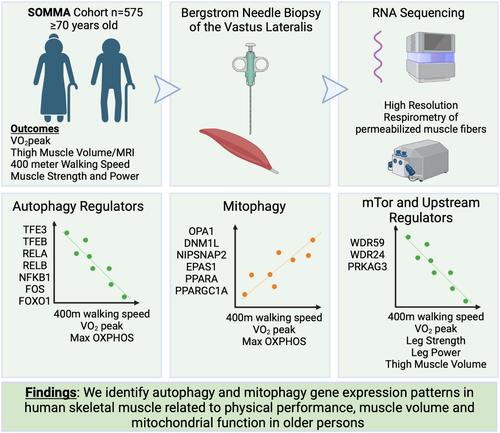当前位置:
X-MOL 学术
›
Aging Cell
›
论文详情
Our official English website, www.x-mol.net, welcomes your feedback! (Note: you will need to create a separate account there.)
Autophagy gene expression in skeletal muscle of older individuals is associated with physical performance, muscle volume and mitochondrial function in the study of muscle, mobility and aging (SOMMA)
Aging Cell ( IF 7.8 ) Pub Date : 2024-04-16 , DOI: 10.1111/acel.14118 Paul M. Coen 1 , Zhiguang Huo 2 , Gregory J. Tranah 3 , Haley N. Barnes 3 , Xiping Zhang 4 , Christopher A. Wolff 4 , Kevin Wu 4 , Peggy M. Cawthon 3, 5 , Russell T. Hepple 6 , Frederico G. S. Toledo 7 , Daniel S. Evans 3, 5 , Olaya Santiago‐Fernández 8 , Ana Maria Cuervo 8 , Stephen B. Kritchevsky 9 , Anne B. Newman 10 , Steven R. Cummings 3, 5 , Karyn A. Esser 4
Aging Cell ( IF 7.8 ) Pub Date : 2024-04-16 , DOI: 10.1111/acel.14118 Paul M. Coen 1 , Zhiguang Huo 2 , Gregory J. Tranah 3 , Haley N. Barnes 3 , Xiping Zhang 4 , Christopher A. Wolff 4 , Kevin Wu 4 , Peggy M. Cawthon 3, 5 , Russell T. Hepple 6 , Frederico G. S. Toledo 7 , Daniel S. Evans 3, 5 , Olaya Santiago‐Fernández 8 , Ana Maria Cuervo 8 , Stephen B. Kritchevsky 9 , Anne B. Newman 10 , Steven R. Cummings 3, 5 , Karyn A. Esser 4
Affiliation

|
Autophagy is essential for proteostasis, energetic balance, and cell defense and is a key pathway in aging. Identifying associations between autophagy gene expression patterns in skeletal muscle and physical performance outcomes would further our knowledge of mechanisms related with proteostasis and healthy aging. Muscle biopsies were obtained from participants in the Study of Muscle, Mobility, and Aging (SOMMA). For 575 participants, RNA was sequenced and expression of 281 genes related to autophagy regulation, mitophagy, and mTOR/upstream pathways was determined. Associations between gene expression and outcomes including mitochondrial respiration in muscle fiber bundles (MAX OXPHOS), physical performance (VO2 peak, 400 m walking speed, and leg power), and thigh muscle volume, were determined using negative binomial regression models. For autophagy, key transcriptional regulators including TFE3 and NFKB-related genes (RELA, RELB, and NFKB1) were negatively associated with outcomes. On the contrary, regulators of oxidative metabolism that also promote overall autophagy, mitophagy, and pexophagy (PPARGC1A, PPARA, and EPAS1) were positively associated with multiple outcomes. In line with this, several mitophagy, fusion, and fission-related genes (NIPSNAP2, DNM1L, and OPA1) were also positively associated with outcomes. For mTOR pathway and related genes, expression of WDR59 and WDR24, both subunits of GATOR2 complex (an indirect inhibitor of mTORC1), and PRKAG3, which is a regulatory subunit of AMPK, were negatively correlated with multiple outcomes. Our study identifies autophagy and selective autophagy such as mitophagy gene expression patterns in human skeletal muscle related to physical performance, muscle volume, and mitochondrial function in older persons which may lead to target identification to preserve mobility and independence.
中文翻译:

在肌肉、活动性和衰老研究中,老年人骨骼肌中的自噬基因表达与身体表现、肌肉体积和线粒体功能相关(SOMMA)
自噬对于蛋白质稳态、能量平衡和细胞防御至关重要,并且是衰老的关键途径。确定骨骼肌自噬基因表达模式与身体表现结果之间的关联将进一步加深我们对蛋白质稳态和健康衰老相关机制的了解。肌肉活检来自肌肉、活动性和衰老研究 (SOMMA) 的参与者。对 575 名参与者的 RNA 进行了测序,并确定了与自噬调节、线粒体自噬和 mTOR/上游途径相关的 281 个基因的表达。使用负二项回归模型确定基因表达与结果之间的关联,包括肌纤维束中的线粒体呼吸 (MAX OXPHOS)、身体表现(VO 2峰值、400 m 步行速度和腿部力量)和大腿肌肉体积。对于自噬,包括 TFE3 和 NFKB 相关基因(RELA、RELB 和 NFKB1)在内的关键转录调节因子与结果呈负相关。相反,还促进整体自噬、线粒体自噬和外自噬的氧化代谢调节因子(PPARGC1A、PPARA 和 EPAS1)与多种结果呈正相关。与此相一致的是,一些线粒体自噬、融合和裂变相关基因(NIPSNAP2、DNM1L 和 OPA1)也与结果呈正相关。对于 mTOR 通路和相关基因,GATOR2 复合物(mTORC1 的间接抑制剂)的两个亚基 WDR59 和 WDR24 以及 AMPK 的调节亚基 PRKAG3 的表达与多种结果呈负相关。我们的研究确定了自噬和选择性自噬,例如与老年人的身体表现、肌肉体积和线粒体功能相关的人类骨骼肌中的线粒体自噬基因表达模式,这可能导致目标识别以保持活动性和独立性。
更新日期:2024-04-16
中文翻译:

在肌肉、活动性和衰老研究中,老年人骨骼肌中的自噬基因表达与身体表现、肌肉体积和线粒体功能相关(SOMMA)
自噬对于蛋白质稳态、能量平衡和细胞防御至关重要,并且是衰老的关键途径。确定骨骼肌自噬基因表达模式与身体表现结果之间的关联将进一步加深我们对蛋白质稳态和健康衰老相关机制的了解。肌肉活检来自肌肉、活动性和衰老研究 (SOMMA) 的参与者。对 575 名参与者的 RNA 进行了测序,并确定了与自噬调节、线粒体自噬和 mTOR/上游途径相关的 281 个基因的表达。使用负二项回归模型确定基因表达与结果之间的关联,包括肌纤维束中的线粒体呼吸 (MAX OXPHOS)、身体表现(VO 2峰值、400 m 步行速度和腿部力量)和大腿肌肉体积。对于自噬,包括 TFE3 和 NFKB 相关基因(RELA、RELB 和 NFKB1)在内的关键转录调节因子与结果呈负相关。相反,还促进整体自噬、线粒体自噬和外自噬的氧化代谢调节因子(PPARGC1A、PPARA 和 EPAS1)与多种结果呈正相关。与此相一致的是,一些线粒体自噬、融合和裂变相关基因(NIPSNAP2、DNM1L 和 OPA1)也与结果呈正相关。对于 mTOR 通路和相关基因,GATOR2 复合物(mTORC1 的间接抑制剂)的两个亚基 WDR59 和 WDR24 以及 AMPK 的调节亚基 PRKAG3 的表达与多种结果呈负相关。我们的研究确定了自噬和选择性自噬,例如与老年人的身体表现、肌肉体积和线粒体功能相关的人类骨骼肌中的线粒体自噬基因表达模式,这可能导致目标识别以保持活动性和独立性。



























 京公网安备 11010802027423号
京公网安备 11010802027423号